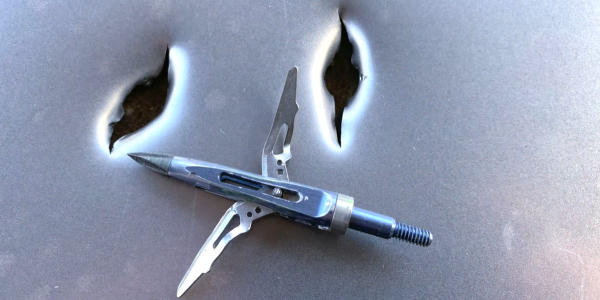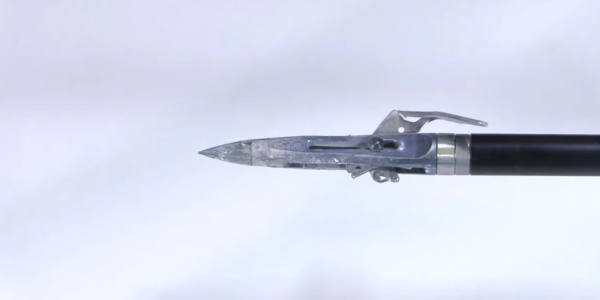In this broadhead review, I tested a tried and true mechanical that has been around for a while… the NAP Killzone.
I’ve used this head on hogs, turkey, and deer, and it has always performed pretty well for me in the field.
But I wanted to see how it performed in my testing regimen.
So, let’s zoom in and go through some of the design features and specifications of the Killzone 125 grain and then we will put it to the test.
NAP Killzone Broadhead Up Close

Here’s a good look at the Killzone. This is a classic, classic rear-deploying head. When the blades are fully opened, it has got a cutting diameter of 2″ in the open position and it doesn’t utilize any O-ring or retention clips or anything like that.

It uses a mechanism where the blades slide back due to pressure right here on these little wing bats on the little hinge. They slide back into their open position. They don’t lock open, but they’re held open just by the force that’s being pushed against them.

The Killzone in the open position. The body of the NAP Killzone is a 7075 aluminum, which as I always say, if you’re going to use aluminum, that’s the way to go, because it’s stronger than some steels. But, it’s very vented, so I definitely wanted to see how it would hold up.

It also has a nice kind of chiseled type tip that’s a hardened steel and the blades are steel as well. By my measurement, they are 0.035″ thick. So, really nice rear-deploying, good size cut, classic, simple mechanical head.
-

The N1 Outdoors® “Rackingham™” Whitetail Tee
Price range: $28.99 through $32.99 Select options This product has multiple variants. The options may be chosen on the product page -
Sale!

N1 Outdoors® Licking Branch Buck LS Tee
$19.00 Select options This product has multiple variants. The options may be chosen on the product page -

N1 Outdoors® Just Pass’N Through™ Broadhead Badge Tee
Price range: $24.99 through $28.99 Select options This product has multiple variants. The options may be chosen on the product page
NAP Killzone Testing
Let’s see how the NAP Killzone performed in the below tests…
For these tests on the Killzone, I used my Bowtech CP28 set at 72 pounds. I used Bishop FOC King Arrows for most of the shots, and Bishop FAD Eliminators for the really hard impact ones.
Flight Forgiveness Test (I field pt then I broadhead @30 yds)
The NAP Killzone broadhead flew almost exactly like the field point.
Initial Sharpness Test

The pre-testing sharpness was 325 (the lower the number, the sharper the blade).
Penetration Test 1

I shot the Killzone into FBI ballistic gel that was fronted with a 2/3″ rubber mat and 1/2″ MDF. It penetrated 5-1/4″.

This was the entrance hole in the foam mat that fronted the MDF and ballistic gel.
Edge Retention Test (sharpness after Penetration Test 1)

Post-test sharpeness = 375.
-

N1 Outdoors® N-Tune™ Nock Tuning Reflective Arrow Wraps – Bowhunt Oh Yeah™
Price range: $18.99 through $27.99 Select options This product has multiple variants. The options may be chosen on the product page -

N1 Outdoors® N-Tune™ Nock Tuning Reflective Arrow Wraps – N-terceptor™
Price range: $18.99 through $27.99 Select options This product has multiple variants. The options may be chosen on the product page -

N1 Outdoors® N-Tune™ Nock Tuning Transparent Arrow Wraps (Non-Reflective)
Price range: $16.99 through $25.99 Select options This product has multiple variants. The options may be chosen on the product page
Our arrow wraps look awesome… but they also do more! [find out HERE!]
Penetration Test 2 (layered cardboard)

The Killzone penetrated through 51 layers of cardboard.
Angled Shot Test (1/4″ MDF/Carpet): No problem.
I shot the Killzone into an angled MDF board… it penetrated it with no problem.
Durability Test (1/2″ MDF max 3 shots)

After the three shots in the MDF, one of the blades started to get pretty bent there. And then the base of the ferrule, the blades cut into that base on both sides pretty much. But overall, it held together pretty well.
Durability Test (22 gauge steel plate max 2 shots)

Here it is after the two shots through the steel plate, and you can see, it held together, but not that great. Both of the blades got significantly bent and they are locked in that position. They would not open or close anymore. The ferrule got a bit narrowed and one of the blades is broken halfway through. And then, you can see the holes on the steel plate… they are a lot smaller than the actual cutting diameter. The blades kind of crunched down on the steel plate.
Durability Test (Concrete Block)

Here it is after impacting the concrete. And as you can see, that one blade that was pretty bent broke off and then the other blade that was pretty bent got even more bent. But, the ferrule held up pretty well. It also had a bit of a wobble. But, it did fairly well for an aluminum, really long-vented, ferrule like that.
Post-Testing Thoughts On The NAP Killzone
So what do you think of the Killzone?
Like I said in the beginning, I’ve used this head in the field and it has performed fairly well for me.
One of the drawbacks has always been its penetration. It’s just never been a very good penetrating head, not just because it has got a big 2-inch wide cut, but it even penetrates less than most mechanicals that are rear-deploying with a 2-inch cut.
And, these tests just exposed a lot of the weaknesses that it does have in penetration as well as in sharpness and in durability.
There are better heads that are on the market, but it doesn’t mean this can’t get the job done. It has killed a lot of animals. It has worked well for me. And if it’s your favorite, then great, more power to you. But, I do think that there are better options available.

The NAP Killzone Scored 77.51 out of 100 possible points.
Also, I have to say, I was really surprised that it fell apart and lost its blades in the cardboard. That happened on a Rage that I tested a while back and I thought that was just kind of freaky. I guess cardboard is a tougher test than I realized! But, it held up through steel plate. That was really interesting.
Anyway, it did relatively well, just not the best. But, check out the score sheet below, and good luck out there hunting!


























































